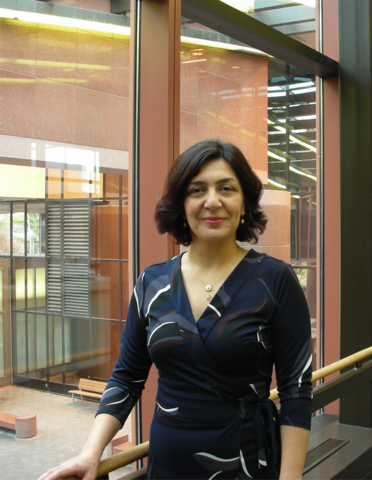
Mersin, a city on the Mediterranean coast of southern Turkey.
How/when did you become interested in science and/or medicine?
I always loved mathematics and liked my science classes. My interest in science soared after being admitted to science high school, a boarding school with extended curriculum concentrated on mathematics and natural sciences. We had devoted time to laboratory science experiments. It was also great to have an opportunity to discuss a topic or an experiment with more senior students and our teachers during the regimented study times at night. Growing up in such a nurturing environment made me want to pursue a career in science.
When did you join the University of Iowa faculty?
August 2008
How or why did you choose to join the faculty at the University of Iowa?
I earned my PhD in Biostatistics at the University of Iowa with a scholarship supporting my studies the entire time. However, after the first year, I realized that getting a research assistantship would provide me better training than only taking lectures. Therefore, I voluntarily suspended my scholarship and started working as a Research Assistant. First, I took part in the design of a clinical trial with a Bayesian approach. During the last two years of my PhD program, I worked for the Department of Anesthesia as a Graduate Assistant and helped with the secondary analysis of a large multi-center randomized clinical trial. Before graduation, I was offered a faculty position within the Department of Anesthesia. I wanted to stay at the University of Iowa because of the nurturing and collaborative environment that the university offers, and the great community that the Iowa City offers to balance career and life.
Is there a teacher or mentor who helped shape your career?
I had many. First, my father for teaching me the importance of not only a hard work ethic but also kindness, honesty, and connecting with people. Dr. Ismet Kan, from Uludag University in Turkey, for reminding me that even if there are dark, cold days, and even if it may feel like a dark winter for a long time, the sun will always shine in the morning and there will always be a spring with blossoming flowers. Dr. Kathryn Chaloner, my late Ph.D. advisor at the University of Iowa, for introducing me to Bayesian analysis, design of clinical trials, and teaching me that there may be different solutions than what is traditionally thought. Dr. Michael Todd for teaching me how to communicate statistics in English to non-statisticians. And finally, Dr. Timothy Brennan for introducing me to the chronic pain field and helping me to align my two passions, Bayesian analysis and postsurgical pain, with ongoing research studies.
How do you see your faculty role impacting medicine and/or science?
My main role in collaborating with others is to help with the design of clinical trials. A well-designed trial means a high quality study. It is easier to publish high quality studies, and eventually they are the ones that can shape the future of medicine and science. My personal area of interest is post-surgical chronic pain. Current research within the Department of Anesthesia is focused on identifying the key predictors of chronic post-surgical pain. Once we can identify those predictors, we may propose preventive or interventional studies to intervene before chronic pain develops.
What is the biggest change you've experienced in your field since you were a student?
When I was an undergraduate student, we were learning only traditional statistical methods from instructors, textbooks, and other publications. Now, with the advancement in technology, I can find answers to many technical questions online.
What one piece of advice would you give to today's students?
Being a student in a medical or a graduate school is hard. Make sure to set aside time for your social life and for personal activities that energize you. You will need a supportive social network during your journey.
In what ways are you engaged in professional activities outside the University (i.e. population based research, mentoring high school students, sharing your leadership/ expertise with organizations or causes, speaking engagement off campus, etc.)?
I am an editorial board member on the biostatistics sections of two academic journals. In addition, I review manuscripts for other journals that publish in my area of interest. I also attend scientific meetings to give oral or poster presentations.
What are some of your outside (personal) interests?
I enjoy spending time with my family, baking, gardening, and Zumba.